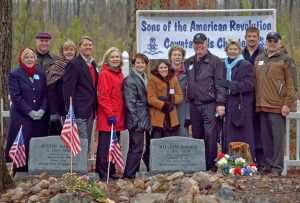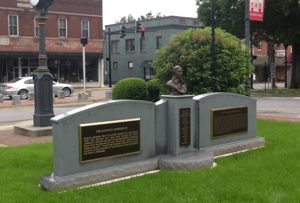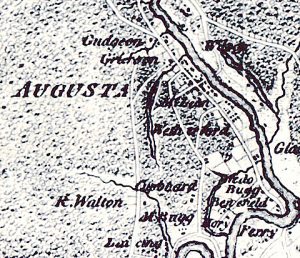George Rockingham Gilmer wrote a heroic saga of the life, service, and sacrifices of Austin Dabney, an African American Georgia Revolutionary War hero. He first published it anonymously in 1849 and reprinted it under his name in a pamphlet in 1851 and in George White’s Historical Collections of Georgia in 1854. Gilmer included it in his own autobiographical collection of undocumented tales in 1855.
In that story, the former governor of Georgia wrote a compelling tale. He described Dabney as passed off as a slave owned by Richard Aycock of Wilkes County. Aycock revealed Dabney’s birth to a white woman making him a free black who could then serve in the military in the place of the cowardly Aycock. Dabney subsequently received a crippling wound at the battle of Kettle Creek on February 14, 1779. A soldier named Harris rescued him from the battlefield and the Harris family nursed Dabney back to health. The crippled veteran would spend the rest of his life returning that kindness to his benefactors, including sending the son of the man who rescued him, William Harris, to Franklin College (today’s University of Georgia) and obtaining for him an apprenticeship with noted lawyer Stephen Upson. This Dabney had connections to the state’s most powerful men.

No history of Austin Dabney has turned up for when he lived to when George R. Gilmer published his account in 1849. Both the pro-slavery advocates and abolitionists missed or ignored this tale. Nothing more appeared in print on the crippled hero of the Revolution until a passing reference during the Civil War and then much later in the eras of the African American Renaissance, the Civil Rights Movement, and the Bicentennial of the American Revolution. Recently, Austin Dabney’s grave was symbolically marked for the third time, along with William Harris’ approximate grave, and he has found mention on the new Black Patriots Monument in Washington, Wilkes County, Georgia.
All else published on Dabney until the 1970s came from this basic story or from embellishments made to it from the imaginations of later writers. No other source published anything on Dabney as America went through an era of deliberately deleting any connection of slaves to the American war for liberty of only some African Americans. Gilmer himself may have invented Dabney’s status as a free man to avoid that problem and he likely told this tale in response to one-time political rivals such as former Governor Wilson Lumpkin and Wilson’s brother Chief Justice Joseph Henry Lumpkin. They accused him of becoming an apologist for the Indian removals of the 1830s and for not being racist enough for the times. Gilmer argued that just as some white people could be, by blood or culture, predisposed to good or evil, so too could civilized and noble persons of other races exist, at least those like Dabney with at least some white blood.

Research completed since the Bicentennial in the 1970s by Frank Parker Hudson and Kenneth H. Thomas Jr. has added a great deal to this story including correcting some of Gilmer’s mistakes in facts. The new information implies much about the crippled soldier having a hidden past. Austin Dabney’s state and later federal invalid soldier pension papers, for example, confirms his birth in Wake County, North Carolina, as also stated by Gilmer, around 1765 according to the 1820 census of Madison County, Georgia. Dabney’s known close associations provide circumstantial evidence for Gilmer’s claim of the later black veteran’s mother coming to there from Richmond and Henrico County, Virginia to give birth and for the baby to somehow become the servant of Richard Aycock. The latter came to Georgia in 1773 from Virginia as among the first settlers of the Ceded lands, what became Wilkes County in 1777.
Austin Dabney’s pension papers, however, attribute his wounds to fighting in Augusta on May 25, 1782 while serving under a Captain Barber and Col. Elijah Clarke, with no mention of the battle of Kettle Creek. The latter by 1849 had become the great Revolutionary War battle in the state’s folklore. No battle took place in Augusta on May 25, 1782 but one year earlier, Clarke’s forces stormed Fort Grierson in Augusta. The Tories (British supporters) inside fled and severe fighting followed of which nothing has survived of the casualties except for the death of Patriot Maj. Pinketham Eaton. Giles Harris, the future father of the William Harris, did not rescue Dabney or anyone at Augusta at that time, as he did not come to Georgia until 1792.
More likely David H. Thurman, a white member of the Wilkes County militia, saved Dabney. His sister Elizabeth, then a child, surely nursed the wounded black soldier. Around 1792, she married Giles Harris. A few years later, probably to protect his personal property from creditors, Austin Dabney deeded all that he owned, including a slave boy named Reuben, to Elizabeth’s then infant son William, the son of Giles Harris. The Thurmonds and Aycocks were neighbors and likely kinsmen.

Contemporary records disagree with other details of Gilmer’s account of Dabney’s life. Colonel Elijah Clarke issued a certificate for bounty land to Richard Aycock for military service and to Aycock for the service of his slave Austin Dabney, evidence of him not a free black and the politically prominent Aycock not a coward. Again, with Elijah Clarke’s influence, the state of Georgia purchased Dabney and emancipated him in 1786.[i]
That same act that bought Dabney his freedom also gave him a state pension for “under the command of Colonel Elijah Clark, and in several actions and engagements, [he] behaved against the common enemy with a bravery and fortitude which would have honored a freedman.” That phrase makes no mention of the circumstances of his wounds, likely to avoid the issue of the illegality in Georgia of allowing slaves to bear arms, and suggests that Dabney fought as a refugee in South Carolina. The act describes him as a “mulatto,” of mixed African and European blood, as Gilmer did also. It further pointed out that many Georgia slaves joined the British army but Dabney stayed to do his duty. The United States government later took over his disability pension.
Austin Dabney left the Aycock family for the Thurmonds and, still later, he attached himself to Giles and Elizabeth Thurmond Harris, and to their son William, in Wilkes, Elbert, Oglethorpe, and Madison counties. Quite likely, these families had earlier ties of blood and marriage to each other in the areas of Henrico County, Virginia, and Wake County, North Carolina. Any connection to the prominent Austin and Dabney families of Henrico County, however, remains unknown. As with so many families of the American frontier, the few slaves and free blacks, such as Austin Dabney, in the white households were likely blood relatives. The crippled black veteran lived with these families and supported himself as a small farmer, gambler, racehorse owner, and merchant.
No record suggests, however, that he or anyone else sent his friend William Harris to what became the University of Georgia. Prominent attorney Stephen Upson of Lexington, Georgia, did apprentice Harris as an attorney, as he had years before to George R. Gilmer. William passed the bar in Oglethorpe County in 1817 and Upson, as a legislator, obtained for Austin Dabney a lifetime control of a fractional land lot in 1821. Gilmer wrote of Dabney having acquaintances to other prominent men but the surviving records and memoirs offer no support for those connections. The crippled old veteran received his last pension payment in March 1830 and must have died by September 1830. William Harris passed away in Pike County, Georgia, in 1838. Harris family tradition has him buried beside his lifelong friend for whom he had named a son Austin Dabney Harris.
Bibliography
The story of Austin Dabney as person and legend must be pieced together from the Wilkes County, Georgia, court and deed records used in conjunction with Kenneth H. Thomas, Jr., “Georgia Family Lines: Harris,” Georgia Life Magazine 2 (Winter 1975-1976): 48-49; Lizzie R. Mitchell, History of Pike County, Georgia (1932); George R. Gilmer, Georgians Sketches of Some of the First Settlers of Upper Georgia (1855); Final Revolutionary War Pension Payment Vouchers: Georgia (National Archives microfilm M1746, roll 2); Watson W. Jennison, Cultivating Race: The Expansion of Slavery in Georgia, 1750-1860 (Lexington, Ky., 2011); and Austin Dabney File, File II Names, Georgia Archives, Morrow.






Recent Articles
The Limits of Environmental Mastery in the Highlands Department
On This Week’s Dispatches: Paul B. Elmore on James Easton’s Feud with Benedict Arnold
The Captives of the Raid on Remensnyder’s Bush, Tryon County, New York, April 3, 1780
Recent Comments
"A Rhode Island Officer’s..."
A fine article about a great victory against the Hessians that reinforced...
"A Rhode Island Officer’s..."
Christian, this is a captivating article backed up with impressive research! Surprisingly,...
"A Rhode Island Officer’s..."
What an interesting piece in tying so many loose ends together. Red...